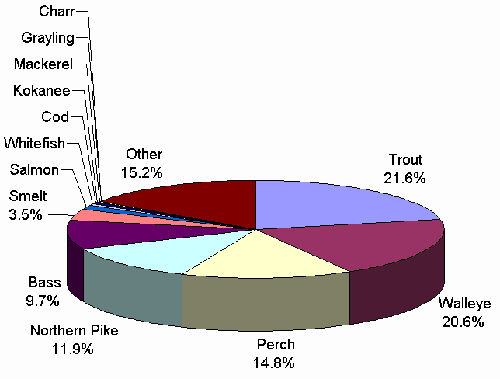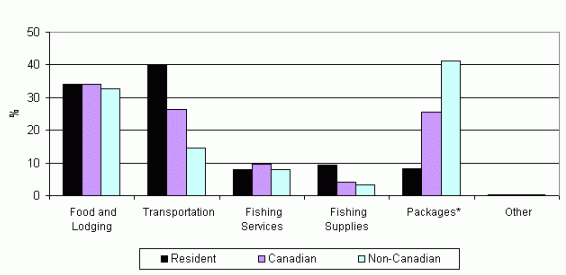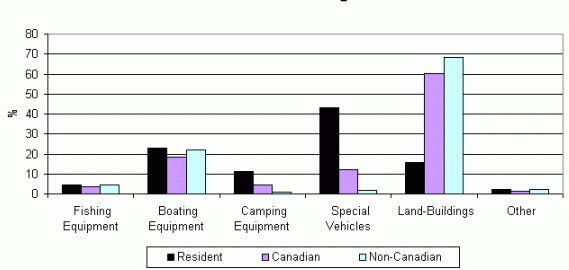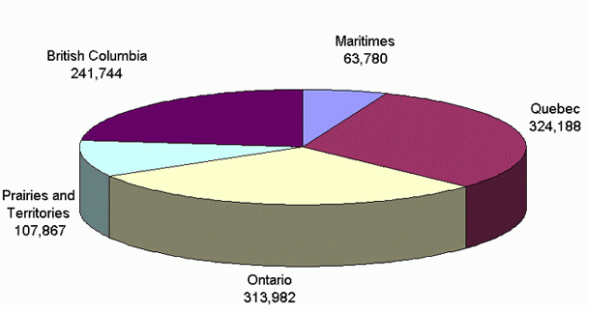2000 Survey of Recreational Fishing in Canada
Survey Highlights
Summary
In 2000, 3.6 million adult anglers participated in a variety of recreational fishing activities in Canada. This represents a steady decline from the 4.2 million in 1995. Despite this, the number of non-Canadian anglers visiting the country in 2000 actually increased by 25,000 compared with 1995. The 3.6 million anglers covered in the survey fished for 47.9 million days and caught 233 million fish of all species. Of the fish caught, only 84.6 million, or 36.4%, were kept.
Recreational fishing is an important economic activity in the natural resources sector. In total, anglers spent $6.7 billion in Canada in 2000. Of this amount, $4.7 billion was directly associated with recreational fishing. Anglers spent over $2.4 billion on trip expenses such as package deals, accommodation, food, transportation, fishing supplies and other services directly related to their angling activities. Investments in 2000 totaled close to $4.3 billion for such durable goods as fishing equipment, boats, motors, camping equipment, special vehicles and real estate. Anglers estimated that almost $2.3 billion of these investment expenditures were wholly attributable to recreational fishing.
Nonresident anglers took over 3.5 million trips in Canada for fishing and other reasons. Visitors to Canada made over 2 million of these trips with the balance being trips by Canadians visiting other provinces and territories. Overall, nonresident anglers fished on 52% of their trips. Non-Canadians fished on 69% of their trips across the border. Of the total days spent in other provinces and territories (4.3 million), visiting Canadian anglers fished on almost 30% of these days. This compares to visiting anglers from other countries, who fished on over 64% of their days spent in Canada.
In 2000, the "Year of the Volunteer", Canadian anglers dedicated over a million days to habitat clean-up and other activities related to enhancing their recreational fishing environment.
The framework of socio-economic and biological information provided in this survey will help managers of this resource better assess and manage fish resources. For example, the consistent decrease in the number of resident anglers could be linked to a change in lifestyle while the catch and release results achieved over the past five years confirm that anglers have increased their efforts to conserve this important natural resource.
In 2000, Canada's newest territory, Nunavut, was surveyed as a separate jurisdiction and not part of the Northwest Territories.
Comparisons with 1995
Comparative information is provided in Appendix 6.
In general terms, there was a 13.9% decrease in the number of active adult anglers since 1995. The number of nonresident. Canadian anglers decreased by 6.3%, whereas the number of non-Canadians increased by 3.3%. As would be expected, the major drop came about due to the drop in the number of resident anglers, falling 18.2%. This is a major factor that must be kept in mind when evaluating all resident information. The number of days that anglers fished dropped by 13.2%, however, the average number of days fished remained fairly steady at 13.2 days for all anglers, and at 15.3 days for resident anglers. Another important result shows that the number of fish caught fell by 8.5% compared with 1995, while the number of fish kept fell by 25.4%, indicating a continuing trend among anglers to practice catch and release. Resident anglers kept 27.3% fewer fish than in 1995 while non-resident Canadians kept 25.8% fewer and foreigners, 12.1% fewer.
There was an 11.6% decrease in major purchases and investments overall, despite a 179% increase made by foreign anglers since the 1995 survey. Resident anglers recorded a decrease in all categories except camping equipment, which had only a modest increase of 3.5%. In 2000, resident anglers spent much less on real estate (down 39%) and fishing equipment (down 26%). Foreign anglers increased their spending significantly on boating equipment (up 285%) and real estate (up 220%). Nonresident Canadians increased their spending in all categories, but most particularly on special vehicles, increasing by 224% over 1995.
The same patterns of spending hold true for direct expenditures on such items as food, lodging and transportation, where an overall decrease of 5.3% was attributed to resident anglers, who spent 18.3% less than in 1995. On average, at $533 per active angler, residents spent the same amount as in 1995. Based on this fact, the drop in direct expenses for fishing was entirely attributed to the drop in the number of resident anglers. Purchases of package deals increased by 41% for foreigners and by 26% for nonresident Canadians, but decreased by 25% for residents.
Angler Profile
There were 3.6 million active adult anglers in Canada in 2000, a decrease of 14% from the 4.2 million in 1995 (Table 1). Of these anglers, 2.7 million were resident anglers (anglers who fished in their home province or territory). Male anglers make up 75% of resident adult anglers, 81% of Canadian nonresident anglers and 86% of all non-Canadian nonresident anglers. On average, active male anglers were somewhat older than active female anglers, 46 years of age compared to 43. Active non-Canadian anglers were older than both residents and visiting Canadian anglers, averaging 50 years for males and 49 years for female anglers.
| Resident | Nonresident Canadian | Nonresident Non-Canadian | Total | |
|---|---|---|---|---|
| Total Active Adult Anglers | 2,688,139 | 173,919 | 774,006 | 3,636,065 |
| Males | 2,008,162 | 141,575 | 668,800 | 2,818,538 |
| average age | 44 | 47 | 50 | 46 |
| Females | 679,977 | 32,344 | 105,206 | 817,527 |
| average age | 42 | 44 | 49 | 43 |
The largest numbers of resident anglers were concentrated in Ontario and Quebec (Table 2), however, the participation rate, that is the proportion of the population taking part in recreational fishing, was highest in Newfoundland and Labrador followed by the Yukon. Additionally, almost 174,000 nonresident Canadian anglers (anglers who lived in Canada but who fished outside their home province or territory), and over 774,000 nonresident foreign anglers (persons who lived outside Canada but fished in this country) actively fished in 2000.
| Jurisdiction | Active Resident Anglers | |
|---|---|---|
| Number | Rate (%) | |
| Newfoundland and Labrador | 101,945 | 19.0 |
| Prince Edward Island | 8,617 | 6.2 |
| Nova Scotia | 56,110 | 6.0 |
| New Brunswick | 53,132 | 7.0 |
| Quebec | 813,590 | 11.0 |
| Ontario | 814,887 | 7.0 |
| Manitoba | 136,334 | 11.9 |
| Saskatchewan | 130,076 | 12.7 |
| Alberta | 182,044 | 6.0 |
| British Columbia Freshwater | 235,691 | 5.8 |
| British Columbia Tidal | 145,495 | 3.6 |
| Yukon Territory | 4,835 | 15.8 |
| North West Territories | 4,720 | 11.5 |
| Nunavut | 662 | 2.4 |
| Total | 2,688,139 | 8.7 |
British Columbia's share of nonresident Canadian anglers, was 37.7%, the highest among jurisdictions. Ontario's share of foreign anglers was 72.8%, maintaining it's status as the most popular fishing destination for non-Canadians.
Approximately 82% of nonresident anglers were foreigners, mainly Americans coming from the East North Central and West North Central census regions of the United States (Figure 1, Table 3). The remaining nonresident anglers were Canadians who fished outside their home provinces and territories, with almost 64% of these anglers coming from the prairie provinces.
Figure 1: Regional distribution of United States residents who held Canadian angling licences in 2000.

| Jurisdiction/State Census Group | Total Number |
|---|---|
| Canadian | |
| Maritimes | 5,413 |
| Quebec | 14,984 |
| Ontario | 36,813 |
| Prairies | 113,998 |
| British Columbia | 8,709 |
| Territories | 1,746 |
| Unspecified Canada | 25 |
| Canada Total | 181,688 |
| Non-Canadian | |
| New England | 11,910 |
| Mid Atlantic | 88,388 |
| East North Central | 334,318 |
| West North Central | 163,615 |
| Mountain | 29,993 |
| Pacific | 83,737 |
| South Atlantic | 37,857 |
| East South Central | 11,066 |
| West South Central | 20,438 |
| Alaska | 1,935 |
| Hawaii | 454 |
| Unspecified U.S.A. | 1,947 |
| Mex.,C.A.,S.A.,Car | 51 |
| United Kingdom | 1,770 |
| Europe | 3,389 |
| Asia | 110 |
| Australia/Pacific Region | 218 |
| Non-Canadian Total | 791,195 |
| All Nonresident Anglers | 972,882 |
Fishing Effort
Fishing is a major recreational activity in Canada, given its abundance of freshwater and its extensive coastlines. Adult anglers fished a total of 47.9 million days in Canada in 2000 (Table 4). Over a third of these days were spent in Ontario followed by a quarter in Quebec. Most fishing activity (93.8%) took place in freshwater.
| Waters | Resident | Nonresident Canadian |
Nonresident Non-Canadian |
Total |
|---|---|---|---|---|
| Freshwater | 38,636,947 | 1,112,932 | 5,178,305 | 44,928,184 |
| Saltwater | 2,518,726 | 162,307 | 276,466 | 2,957,499 |
| Total | 41,155,673 | 1,275,239 | 5,454,771 | 47,885,683 |
| Average Days Fished | 15.3 | 7.3 | 7.0 | 13.2 |
Resident anglers fishing within their home jurisdictions accounted for 86% of all days fished in 2000. Only 2.7% of total fishing effort was attributed to Canadians fishing in other jurisdictions, while foreign anglers accounted for the remaining 11.3% of days fished in 2000. Resident anglers fished an average of 15.3 days, while nonresident Canadians averaged 7.3 days and non-Canadians 7.0 days.
Harvest
In 2000, anglers caught almost 233 million fish of all species and retained about 85 million (Tables 5 and 6). Resident anglers caught 73% of the fish and they kept over 84% or, on average, 26 fish each over the year. Nonresident Canadians kept an average of 7 fish each, while visiting foreign anglers retained an average of 16 fish of all species. About 46% of all fish reported were caught in the province of Ontario, however, the overall proportion of fish retained by anglers in Ontario was only 31%, compared to 42% for anglers in Quebec.In terms of species (Figure 2), trout accounted for 21.6% of all fish caught, followed by walleye (20.6%) and perch (14.8%). For both nonresident angler groups, walleye was the species caught most often accounting for 25.6% of the foreign angler catch and 34.4% of the nonresident Canadian catch (Table 5). Walleye also accounted for the highest proportion of species retained by these anglers (27% and 32 % respectively).
| Species | Resident | Nonresident Canadian |
Nonresident Non-Canadian |
Total |
|---|---|---|---|---|
| Trout | 46,515,329 | 1,140,144 | 2,674,814 | 50,330,287 |
| Walleye | 24,965,495 | 1,478,297 | 20,296,185 | 46,739,977 |
| Perch | 27,042,739 | 705,344 | 6,613,220 | 34,361,303 |
| Northern Pike | 14,899,533 | 1,141,175 | 11,757,325 | 27,798,033 |
| Bass | 14,478,513 | 353,664 | 7,691,806 | 22,523,983 |
| Smelt | 8,207,188 | 541 | 12,894 | 8,220,623 |
| Salmon | 2,668,898 | 298,441 | 599,174 | 3,566,513 |
| Whitefish | 1,061,229 | 33,702 | 97,212 | 1,192,143 |
| Cod | 1,083,160 | 1,886 | 1,160 | 1,086,206 |
| Kokanee | 562,828 | 77,531 | 28,742 | 669,100 |
| Mackerel | 516,855 | 3,476 | 458 | 520,789 |
| Grayling | 157,774 | 45,671 | 153,963 | 357,408 |
| Charr | 84,424 | 3,971 | 4,055 | 92,451 |
| Other | 25,729,080 | 497,624 | 9,079,788 | 35,306,492 |
| Total | 167,973,042 | 5,781,469 | 59,010,797 | 232,765,309 |
Overall, anglers retained 36.4% of the fish they caught. Resident anglers kept 42.3%; nonresident anglers, 21.8%; and, foreign anglers, 20.9% (Table 6).
| Species | Resident | Nonresident Canadian |
Nonresident Non-Canadian |
Total | % Kept |
|---|---|---|---|---|---|
| Trout | 26,492,685 | 251,746 | 422,524 | 27,166,955 | 54.0 |
| Perch | 11,633,052 | 131,461 | 2,839,952 | 14,604,465 | 42.5 |
| Walleye | 10,761,937 | 408,410 | 3,287,214 | 14,457,561 | 30.9 |
| Smelt | 7,034,018 | 419 | 12,143 | 7,046,580 | 85.7 |
| Northern Pike | 3,405,072 | 153,181 | 894,662 | 4,452,915 | 16.0 |
| Bass | 2,445,935 | 27,135 | 814,885 | 3,287,954 | 14.6 |
| Salmon | 1,032,369 | 75,360 | 174,352 | 1,282,081 | 35.9 |
| Cod | 1,024,191 | 1,463 | 542 | 1,026,196 | 94.5 |
| Mackerel | 452,555 | 2,583 | 366 | 455,503 | 87.5 |
| Kokanee | 369,675 | 58,488 | 16,827 | 444,991 | 66.5 |
| Whitefish | 379,586 | 7,255 | 29,658 | 416,499 | 34.9 |
| Charr | 53,533 | 1,202 | 262 | 54,997 | 59.5 |
| Grayling | 20,942 | 6,790 | 12,173 | 39,905 | 11.2 |
| Other | 5,941,770 | 137,677 | 3,810,077 | 9,889,524 | 28.0 |
| Total | 71,047,320 | 1,263,171 | 12,315,636 | 84,626,127 | 36.4 |
| % kept | 42.3 | 21.8 | 20.9 | 36.4 |
In general, anglers kept higher proportions of salt-water fish such as cod (95%), mackerel (88%) and smelt (86%) compared to freshwater species such as trout (54%), perch (43%) and salmon (36%). The species least favoured for retention were northern pike (16%), bass (14.6%) and grayling (11.2%).
Figure 2: Fish Caught by Species

Nonresident Trip Characteristics
Nonresident anglers made over 3.5 million trips within Canada and fished on 52.4% of their trips (Table 7). Nonresident Canadian anglers fished on only 30.4% of their trips to other jurisdictions, while anglers visiting Canada fished on 69.2% of their trips, underlining the appeal of Canada as a fishing destination. Nonresidents spent a total of 12.8 million visitor days, of which over half (52.7%) were spent fishing. Day trips for fishing accounted for almost 30% of all fishing trips in 2000, but only 8% of all days fished.
| Characteristics | Nonresident Canadian | Nonresident Non-Canadian |
Total |
|---|---|---|---|
| Trips - All Reasons | 1,527,657 | 2,006,225 | 3,533,882 |
| Fishing Trips | 464,627 | 1,388,853 | 1,853,480 |
| - % of all trips | 30.4 | 69.2 | 52.4 |
| Days Spent for All Reasons | 4,264,746 | 8,497,539 | 12,762,285 |
| Days Fished | 1,275,239 | 5,454,771 | 6,730,010 |
| - % of all trips | 29.9 | 64.2 | 52.7 |
| Day Trips for Fishing | 131,361 | 418,287 | 549,648 |
| Total Nights Spent on Fishing Trips | 1,820,419 | 5,828,690 | 7,649,109 |
Nonresidents visiting Canada, primarily visiting the province of Ontario, had a proportionately higher percentage of day trips than Canadians visiting other jurisdictions, reflecting the proximity of Ontario to large American border cities.
Almost 39% of Canadians fishing outside their home jurisdictions chose British Columbia as a destination with 21.2% fishing in tidal waters and 16.6% fishing in freshwater. Ontario was the second most popular destination with 24.3% of Canadian nonresidents fishing in the province and accounting for 27.6% of the days spent by nonresident Canadian on fishing trips.
Ontario was the destination on 71% of all nonresident, non-Canadian anglers' trips, 72% of their days spent in Canada and 76% of their days fished. British Columbia's freshwater and tidal water fisheries accounted for about 5% of the days spent by non-Canadians. A total of 7.6 million nights were spent by all non-resident anglers while fishing in Canada, with more than 5.4 million spent on overnight trips by non-Canadians. About 76% of these nights were spent in Ontario.
Direct Expenditures
Despite a decrease of almost 14% in the number of anglers, only a limited decrease of 5% in direct expenditures was reported. An overall drop in the numbers of resident anglers, despite consistent average spending, was responsible for the decrease. Anglers spent $2.4 billion on goods and services directly related to their angling activities (Table 8, Figure 3). Resident anglers spent $1.4 billion of this amount (59.7%), or $533 per angler (no change from 1995). Canadian nonresidents spent $138 million (6.8%), or $794 per angler and foreign nonresidents spent $830 million (34.6%), with an average of $1,072 per angler.
| Expenditure | Resident | Nonresident Canadian | Nonresident Non-Canadian |
Total |
|---|---|---|---|---|
| Food and Lodging | 486,197,223 | 47,053,794 | 270,758,686 | 804,009,703 |
| Transportation | 575,378,038 | 36,606,364 | 120,436,536 | 732,420,939 |
| Fishing Services | 114,155,479 | 13,127,554 | 66,329,577 | 193,612,611 |
| Fishing Supplies | 134,833,213 | 5,593,775 | 28,050,158 | 168,477,145 |
| Packages1 | 116,606,418 | 35,231,935 | 342,210,908 | 494,049,261 |
| Other | 5,055,325 | 526,116 | 2,189,248 | 7,770,690 |
| Total | 1,432,225,696 | 138,139,539 | 829,975,113 | 2,400,340,348 |
| Average Per Active Angler | 532.79 | 794.28 | 1,072.31 | 660.15 |
Transportation costs was the largest single category for resident anglers at $575 million, or 40% of all trip expenses. The next largest outlay by residents was for food and lodging, for which residents spent $486 million, or 34% of the total. As a single category, non-resident Canadians spent more on food and lodging (34%). However, transportation costs and package deals were areas of significant expenditure, accounting for 26% and 25% of total expenses, respectively. Non-Canadians spent the largest amount of their direct expenditures on package deals, totaling $342, or 41% of all trip expenses. An additional $271 million was spent on food and lodging costs, accounting for an additional 33% of direct expenditures.
Over 41% of all expenditures were made in Ontario, followed by 19.7% in British Columbia (expenditures in tidal waters at 10.8%; in freshwater at 8.9%), followed by Quebec at 19.5%. For those purchasing package deals, most was spent in Ontario at 41%, followed by Quebec at 17% and British Columbia tidal waters at 16%.
Ontario residents accounted for 33% of all expenditures made by resident anglers followed by Quebec at 29%. Nonresident Canadians favoured British Columbia, with 31% of their total direct expenditures made for fishing in tidal waters. Nonresident non-Canadians spent an overwhelming 62% of their direct expenditures in Ontario.
Figure 3: Expenditures directly attributable to recreational fishing.

Investments
In 2000, anglers invested almost $4.3 billion in boats, motors, camping gear, special vehicles, real estate and other durable goods (Table 9, Figure 4). Of this total, they estimated that $2.3 billion was directly attributable to their fishing activities.
| Purchase or Investment | Resident | Nonresident Canadian | Nonresident Non-Canadian |
Total |
|---|---|---|---|---|
| Fishing Equipment | 184,065,353 | 4,888,301 | 8,484,218 | 197,437,872 |
| Boating Equipment | 906,431,192 | 23,604,395 | 39,600,813 | 969,636,399 |
| Camping Equipment | 446,329,680 | 5,709,014 | 1,343,629 | 453,382,323 |
| Special Vehicles | 1,725,758,988 | 15,842,211 | 3,004,257 | 1,744,605,456 |
| Land-Buildings | 634,960,759 | 77,770,626 | 122,922,669 | 835,654,054 |
| Other | 89,015,128 | 1,725,643 | 4,435,071 | 95,175,841 |
| Total | 3,986,561,099 | 129,540,190 | 179,790,656 | 4,295,891,945 |
| Average Per Active Angler | 1,483.02 | 744.83 | 232.29 | 1,181.47 |
Resident anglers accounted for 92.8% of the total. Special vehicles such as ATV's and campers remain the most popular investment items totaling over $1.7 billion, of 42% of their total expenditures. These expenditures averaged almost $1,500 per active angler. Non-resident Canadians spent $78 million out of a total of $130 million on land and buildings. Expenditures for boating equipment and special vehicles accounted for an additional $22 million. The average expenditure per active angler was almost $750. Non-Canadian anglers spent almost $123 million out of almost $180 million of their investments on land and buildings (68%). In addition, these anglers spent almost $40 million on boating equipment (22%). The average expenditure per active anglers was almost $225.
Most investment expenditures were made in the province of Ontario (31.2%), followed by Quebec (25.7%), British Columbia (17.0%) and Alberta (11.3%).
Anglers were asked to estimate what percentage of each investment expenditure category was wholly attributable to their recreational fishing activities. Resident anglers indicated that $2.1 billion, or 53% of their total investment expenditures were directly related to recreational fishing activities. When comparing categories of investment, although special vehicles represented the majority of total investment expenditures in 2000, the attributable amount of purchases related to boating equipment surpassed special vehicles, accounting for 32% of the total, compared to 28% for special vehicles. Similarly, nonresident Canadians estimated that $58 million (45% of the total) was wholly attributable to recreational fishing. As was the case for total investments, land and buildings represented the main category for wholly attributable investment expenditures. For non-Canadians, the attributable amount was over $131 million (73% of the total), with land and buildings remaining the principal investment category. In total, anglers estimated that $2.3 billion, or 53% of their total investment, was attributable to their recreational fishing activities (Table 10, Figure 5).
| Purchase | Resident | Nonresident Canadian | Nonresident Non-Canadian |
Total |
|---|---|---|---|---|
| Fishing Equipment | 184,065,353 | 4,888,301 | 8,484,218 | 197,437,872 |
| Boating Equipment | 673,522,359 | 17,935,795 | 30,250,814 | 721,708,967 |
| Camping Equipment | 246,772,071 | 3,010,586 | 1,094,293 | 250,876,950 |
| Special Vehicles | 590,985,876 | 4,406,254 | 872,070 | 596,264,200 |
| Land-Buildings | 323,345,233 | 26,063,107 | 86,954,603 | 436,362,943 |
| Other | 75,941,450 | 1,441,641 | 3,796,249 | 81,179,340 |
| Total | 2,094,632,342 | 57,745,682 | 131,452,246 | 2,283,830,271 |
| Average Per Active Angler | 779.21 | 332.03 | 169.83 | 628.11 |
Figure 4: Distribution of investments made in whole or in part for recreational fishing.

Figure 5: Distribution of investments directly attributable to recreational fishing.

Volunteer Work in Support of Recreational Fisheries
The year 2000 was declared the "Year of the Volunteer" in Canada. In response to this initiative, anglers were asked to provide information on the days they devoted to such activities as habitat clean up, fish passage construction, stream stewardship, etc. The survey found that Canadian anglers spent over a million days on activities related to enhancing the recreational fisheries environment. Quebec and Ontario anglers devoted over 300,000 days in each of these provinces, followed by over 240,000 in British Columbia. Figure 6 shows the breakdown of the number of volunteer days by resident Canadians anglers.
Figure 6: Distribution of Volunteer Days Spent by Canadians in support of recreational fisheries.

- Date modified: